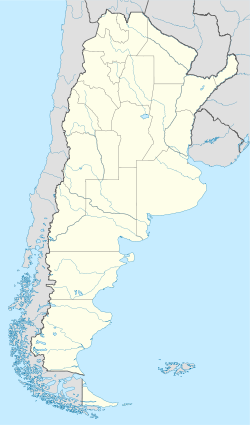- Neuquén, Argentina
-
Neuquén — City — (From top to bottom; from left to right) Aerial view of the city; Neuquén branch of the Museo Nacional de Bellas Artes; Whimsical fountain; Neuquén Legislature and the Ruca Che Stadium. Flag of Neuquén
Flag
Coat of armsLocation of Neuquén in Argentina Coordinates: 38°57′S 68°14′W / 38.95°S 68.233°WCoordinates: 38°57′S 68°14′W / 38.95°S 68.233°W Country Argentina Province Neuquén Department Confluencia Government – Mayor Martín Farizano (Front for Victory) Elevation 250 m (820 ft) Population – Total 355,080 Time zone ART (UTC−3) CPA base Q8300 Dialing code +54 299 Neuquén (Spanish pronunciation: [neuˈken]) is the capital city of the Argentine province of Neuquén, located in the east of the province, at the confluence of the Limay and Neuquén rivers. The city has a population of more than 265,000, making it the largest city in Patagonia.
Neuquén is both an important agricultural center, surrounded by fertile lands irrigated by the waters of the Limay and Neuquén rivers in an otherwise arid province, and a petrochemical industrial center that receives oil extracted from different points of the province. It belongs economically and geographically to the Alto Valle region that produces apples, pears, and other fruits.
National Route 22 divides the city into two halves. The Presidente Perón Airport (IATA: NQN, ICAO: SAZN), at 38°56′S 68°08′W / 38.933°S 68.133°W, is eight kilometers away from the city and serves regular flights to Buenos Aires, San Carlos de Bariloche, Comodoro Rivadavia, Río Gallegos, Río Grande, Ushuaia, and San Martín de los Andes.
Contents
History
In 1885, the lands of what was at that time called Confluencia (i.e., "confluence," referring to the two rivers) were auctioned to a few people. Shortly after the Conquest of the Desert campaign conducted by the military over Patagonia, the Mapuche and Tehuelche tribes that inhabited the province of Neuquén were either killed or pushed out of these lands.
Since there was no defined border with Chile, the Argentine government reached an agreement with the British-owned Buenos Aires Great Southern Railway company that was constructing a railway network, mainly in Buenos Aires Province, to build an extension to the town in exchange for lands, in order to populate it. In 1899, the railroad reached Cipolletti in Río Negro province, and three years later, after the construction of the bridge, arrived at Neuquén.
Neuquén was officially founded on September 12, 1904, and the capital of the territory was transferred from Chos Malal to the young town. The name "Neuquén" derives from the Mapudungun word nehuenken, meaning drafty, which the native people used in reference to this river.
By 1930, the town had only 5000 inhabitants. In the 1960s, it acquired a new importance when oil deposits were found in the province by the state company YPF. The 1970s and 1980s saw massive demographic growth, accompanied by improvements such as the creation of the National University of Comahue in 1971.
Climate
Neuquén has an arid climate, with 180 millimetres (7 in) of precipitation per year. There are marked temperature differences in the seasons: In summer (November to March), the temperature can reach 31 °C (88 °F), but low humidity and strong winds from the South make the temperature feel less than it would be otherwise. Autumns (April to May), are mild, typically a transition season.
Snow can be present, (ex. in 2010). Winter (June to August), highs usually reach 12 °C (54 °F), but on many days the high doesn't reach 4 °C (39 °F). Nights are cold, under 0 °C (32 °F), sometimes reaching −10 °C (14 °F). spring (September to October) is usually just as mild as autumn.
Museums
The Museo Nacional de Bellas Artes, designed by Mario Roberto Alvarez, opened in 2004. The museum showcases both national and international artists. The building consists of 4 halls which include both the temporary and the permanent collection, as well as an auditorium and theater.
Climate data for Neuquén, Argentina Month Jan Feb Mar Apr May Jun Jul Aug Sep Oct Nov Dec Year Average high °C (°F) 31.8
(89.2)31
(88)27.2
(81.0)21.4
(70.5)16.7
(62.1)11.9
(53.4)11.3
(52.3)15.7
(60.3)18.6
(65.5)23.2
(73.8)27.7
(81.9)30.5
(86.9)22.5 Daily mean °C (°F) 23.5
(74.3)22.5
(72.5)19.2
(66.6)14.1
(57.4)9.8
(49.6)6.4
(43.5)5.1
(41.2)8.6
(47.5)11.3
(52.3)15.6
(60.1)19.7
(67.5)22.5
(72.5)14.8 Average low °C (°F) 15.3
(59.5)14
(57)11.2
(52.2)6.9
(44.4)3
(37)1
(34)−1
(30)1.5
(34.7)4
(39)8.1
(46.6)11.7
(53.1)14.7
(58.5)7.6 Precipitation mm (inches) 12.7
(0.5)10
(0.39)33.2
(1.307)11.3
(0.445)10.1
(0.398)25.1
(0.988)17.8
(0.701)11.2
(0.441)23.8
(0.937)10.7
(0.421)7.9
(0.311)8.9
(0.35)182.7
(7.193)Source: Servicio Meteorológico Nacional[1] Sister cities
Neuquén is sister city, as designated by Sister Cities International with:
References
- ^ "(English) Datos meteorológicos ciudades argentinas". http://www.smn.gov.ar/?mod=clima&id=5. Retrieved Dec 2008.
- ^ Ilustre Municipalidad de Valdivia, ed (18 de noviembre de 2003). "Esta noche se firmará acuerdo entre Neuquén y Valdivia". http://www.munivaldivia.cl/noticias/2003/noviembre/sem4.html#neuquen. Retrieved 22 de julio de 2009.
External links
- (Spanish) Municipality of Neuquén - Official website.
- Municipal information: Municipal Affairs Federal Institute (IFAM), Municipal Affairs Secretariat, Ministry of Interior, Argentina. (Spanish)
Provincial capitals of Argentina La Plata, Buenos Aires · San Fernando del Valle de Catamarca, Catamarca · Resistencia, Chaco · Rawson, Chubut · Córdoba, Córdoba · Corrientes, Corrientes · Paraná, Entre Ríos · Formosa, Formosa · San Salvador de Jujuy, Jujuy · Santa Rosa, La Pampa · La Rioja, La Rioja · Mendoza, Mendoza · Posadas, Misiones · Neuquén, Neuquén · Viedma, Río Negro · Salta, Salta · San Juan, San Juan · San Luis, San Luis · Río Gallegos, Santa Cruz · Santa Fe, Santa Fe · Santiago del Estero, Santiago del Estero · Ushuaia, Tierra del Fuego · San Miguel de Tucumán, Tucumán

Neuquén - Plottier - Cipolletti Categories:- Capitals of Argentine provinces
- Populated places in Neuquén Province
- Populated places established in 1904
Wikimedia Foundation. 2010.




